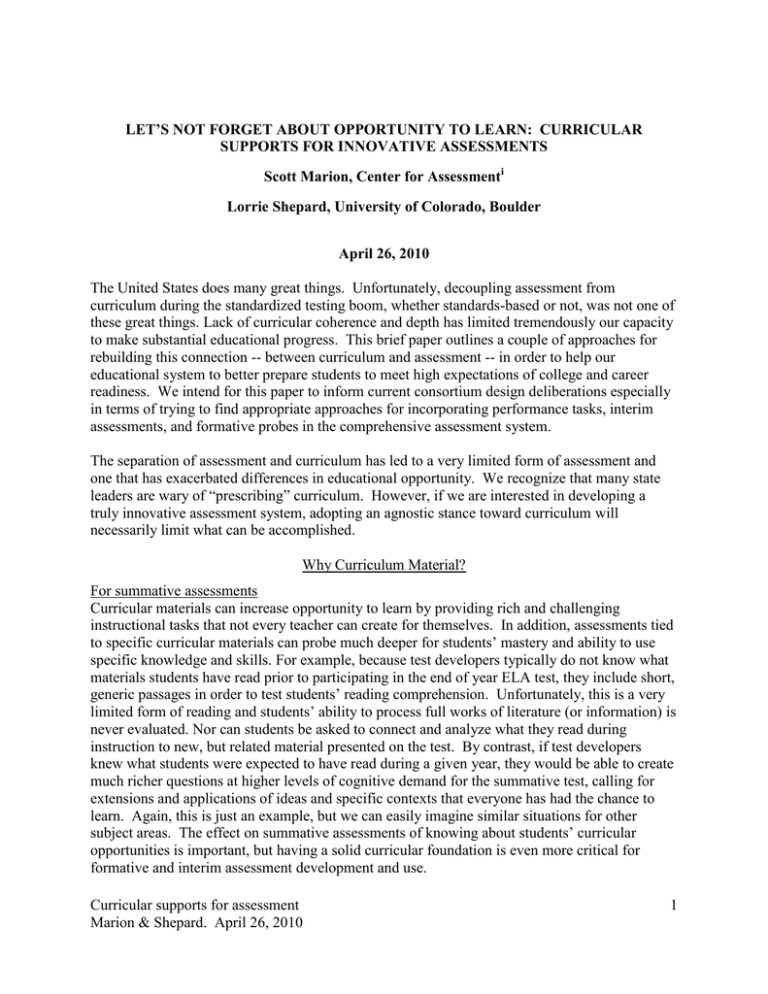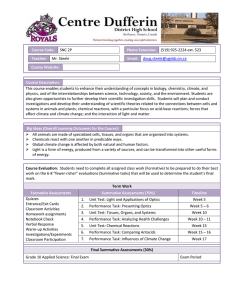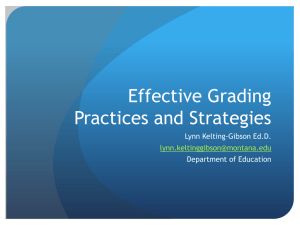LET’S NOT FORGET ABOUT OPPORTUNITY TO LEARN: CURRICULAR
advertisement

LET’S NOT FORGET ABOUT OPPORTUNITY TO LEARN: CURRICULAR SUPPORTS FOR INNOVATIVE ASSESSMENTS Scott Marion, Center for Assessmenti Lorrie Shepard, University of Colorado, Boulder April 26, 2010 The United States does many great things. Unfortunately, decoupling assessment from curriculum during the standardized testing boom, whether standards-based or not, was not one of these great things. Lack of curricular coherence and depth has limited tremendously our capacity to make substantial educational progress. This brief paper outlines a couple of approaches for rebuilding this connection -- between curriculum and assessment -- in order to help our educational system to better prepare students to meet high expectations of college and career readiness. We intend for this paper to inform current consortium design deliberations especially in terms of trying to find appropriate approaches for incorporating performance tasks, interim assessments, and formative probes in the comprehensive assessment system. The separation of assessment and curriculum has led to a very limited form of assessment and one that has exacerbated differences in educational opportunity. We recognize that many state leaders are wary of “prescribing” curriculum. However, if we are interested in developing a truly innovative assessment system, adopting an agnostic stance toward curriculum will necessarily limit what can be accomplished. Why Curriculum Material? For summative assessments Curricular materials can increase opportunity to learn by providing rich and challenging instructional tasks that not every teacher can create for themselves. In addition, assessments tied to specific curricular materials can probe much deeper for students’ mastery and ability to use specific knowledge and skills. For example, because test developers typically do not know what materials students have read prior to participating in the end of year ELA test, they include short, generic passages in order to test students’ reading comprehension. Unfortunately, this is a very limited form of reading and students’ ability to process full works of literature (or information) is never evaluated. Nor can students be asked to connect and analyze what they read during instruction to new, but related material presented on the test. By contrast, if test developers knew what students were expected to have read during a given year, they would be able to create much richer questions at higher levels of cognitive demand for the summative test, calling for extensions and applications of ideas and specific contexts that everyone has had the chance to learn. Again, this is just an example, but we can easily imagine similar situations for other subject areas. The effect on summative assessments of knowing about students’ curricular opportunities is important, but having a solid curricular foundation is even more critical for formative and interim assessment development and use. Curricular supports for assessment Marion & Shepard. April 26, 2010 1 Interim assessments Common curricular opportunities allow for sensible inclusion of interim or benchmark assessments. When interim assessments are tied closely to curriculum, teachers and others have an easier time interpreting the results for program evaluation and/or remediation because they do not have to figure out first if what was tested was covered in the curriculum (assuming a good test design). Similar to the argument for summative assessments, situating the interim assessments at the end of a common curricular unit allows for the assessments to validly measure deeper and contextualized information. This curriculum-assessment link also allows for reports to be structured that directly relate the assessment results to the big ideas that what students were intended to learn. Formative assessment There is some academic debate about whether formative assessment must be based in a strong curriculum or whether expertise about its use can be developed independent of content. It is clear, however, that formative assessment must eventually connect with curriculum and instruction for follow-up actions to be effective. We are not advocating for a common set of formal, “formative assessments” to be imposed across all states (or even schools) within consortia, which would only result in another layer of instruction-interrupting data collection. Formative assessment is an integral part of the teaching and learning process that must be tailored for use within each classroom and ideally between each student and his/her teacher. Developing teachers’ formative assessment skills works best when teachers have opportunities to analyze student work based on key assessment tasks anchored to learning progressions. This provides them with opportunities to gain experience with common misconceptions and build their repertoire of instructional strategies for moving forward. It will likely be more efficient for consortia (or state) professional development leaders when participating teachers use a common set of curriculum materials so that when teachers tried out techniques, for example, there was a common framework for interpreting the results. We offer two examples of how curriculum can be included in a consortium’s assessment system design. We first discuss a model curriculum framework that could be available to all schools in a given consortium. For consortia that either do not want to develop a full model curriculum, we discuss the use of curriculum “replacement” units that can serve as anchors for assessment and professional development. Of course, there is no reason why consortia must limit their choices to one or the other. It would be entirely sensible and complementary for consortia to pursue both approaches. For example, a consortium might fully develop a cross-grade curriculum framework in writing but make available only selected model replacement units in math. Model Curriculum Frameworks Many have high aspirations for the clarity and instructional guidance that will be provided by the Common Core State Standards (CCSS). It might be true that the CCSS are an improved set of content standards compared to what most states have now. Unfortunately, it does not then follow that new clearer, higher will solve the curriculum problem, because content standards cannot typically be written at a level of detail necessary to guide teachers’ daily practice. Therefore, there needs to be some type of document or other material that translates the content standards into guides for daily instruction and assessment. A common curriculum across all consortium states would be one such translation, but not one that we would support. The idea of Curricular supports for assessment 2 Marion & Shepard. April 26, 2010 consortia was intended to allow for the development of curricula, but currently proposed consortia are now too large to allow for deep and thoughtful development of curricula and would instead recreate the politics of current mile-wide, inch-deep textbook and test development issue. However, model curriculum frameworks that are considerably more specific than content standards, especially in terms of scope and sequence, but not as specific as a formal curriculum could serve as an effective compromise. These frameworks should be developed eventually for all grades and content areas tested, but the implementation should be voluntary at least at the state level. These model curricula must have enough specificity so that assessment designers have a clear understanding of the context of learning and so that teachers have a framework for both interpreting the assessment results and planning the next instructional actions. Curricular “Replacement” Units Our vision for replacement units is similar to the types of units developed by Marilyn Burns in her elementary mathematics work, to FOSS kits, and to the College Board’s former Pacesetter program that focused on high school material. These units are designed to address the same topics as existing units, but would do so in ways that embody the common core standards and promote deeper learning than typically occurs. Therefore, these units can replace existing units and would not be an add-on to an already overcrowded curriculum. These curricular units, which can also be called assessment supports if it is more politically appealing, would include coherently developed instructional tasks, sample formative questions for teachers to ask or things to look for in student work to get at key conceptual understandings and would serve as the basis for interim performance tasks and as a context for summative assessment. These units could be designed in an online environment (as could the model curricula) to capitalize on potential for innovation and supplementary training materials for teachers and supports for students. In addition to training materials for teachers on curricular implementation, these units should include training materials and supports for implementing formative assessment and progress monitoring strategies within each unit. These units should be deep and flexible enough for teachers to use each year. If the state/consortia was going to use these units as a basis for some “through-course” summative performance tasks, it would be easy enough to do so by creating new/comparable assessment tasks such as a different science experiment or grade-level text, while assessing same concepts (e.g., standards). The units could and probably should differ in depth and scope depending on grade level. High school units should probably be designed to fit within specific courses, while elementary units would tend to be a bit more generic. Further, at elementary and perhaps even at middle school, units and associated performance tasks that integrate content from multiple subject areas could be designed as a way to address legitimate concerns about the narrowing of the curriculum. Depending on grade level, we envision eventually implementing approximately 2-6 of these units throughout the year, varied by grade level and subject. States or districts could phase-in the development and implementation of these units and associated assessments over time by either implementing one or two units per grade level and content area or focusing on a few key grades at first. We also suggest implementing different types of units with some as short as a few days with others as long as a couple of weeks. Each unit should focus on a “big idea” of the domain and should be used strategically within existing curricula (e.g., perhaps at the end of a longer unit of study). These units would be designed to instantiate key aspects of the common standards, Curricular supports for assessment 3 Marion & Shepard. April 26, 2010 and could also be designed to extend and deepen the common standards. These replacement units would be built to relate to a model curriculum framework as described above and could be a more modest and appropriate means for moving toward a model curriculum, especially if evaluation studies were conducted to determine the usefulness and effectiveness of replacement units for improving student learning. Each of the replacement units would be designed with formative assessment strategies and probes and a culminating unit assessment that could, if desired, be used either as part of the interim or summative systems. The replacement units and associated assessment materials should be designed to facilitate instructionally useful follow-up actions for example by suggesting effective challenge questions and activities linked to typical misconceptions and/or still fragile knowledge. Additionally, and as discussed in the curriculum framework section above, some of the content and specific examples used on the summative assessment could be extensions of work drawn from the curricular units to help move past some of the superficial aspects of current summative assessments. Curriculum and the Race-to-the-Top Assessment Competition We are well aware that some state leaders view curriculum as the third rail of state education politics. We are not advocating a common, required curriculum across all schools in a given consortium. We are suggesting, however, that consortium leaders have the responsibility to help educators translate the common standards into more instructionally-relevant materials. A model curriculum is one such tool. Or, it might be useful to convene multiple curriculum teams to create “competing” curricula in order to conduct some natural experiments. The replacement units and associated assessments could be provided to districts and schools to be implemented on an optional basis or a state could require only a limited implementation while leaving the majority of units as options. On a more practical note, we believe that it would be difficult to spend $160 million well solely on developing assessment items and tasks. Spending a substantial portion of these funds to developing curriculum materials, formative assessment probes, interim tasks, and professional development models will be money well spent to help fulfil the goals of improving students’ readiness for college and careers. Further, the Department’s Notice Inviting Applications (NIA) as well as previous USED documents discussing the assessment competition made clear USED’s interest in having teachers involved in the assessment system. This is an area where expert teachers working with content and assessment experts could make great contributions toward the system by helping to design these units. i This paper is one of a series of brief documents produced by the Center for Assessment designed to assist state consortium leaders in thinking about and preparing their responses to the United States Department of Education Notice Inviting Applications for Comprehensive and High School Assessment System grants. Funding has been provided by the Bill & Melinda Gates Foundation. The views expressed in this paper are those of the authors and do not necessarily reflect the views of the Gates Foundation. Curricular supports for assessment Marion & Shepard. April 26, 2010 4



